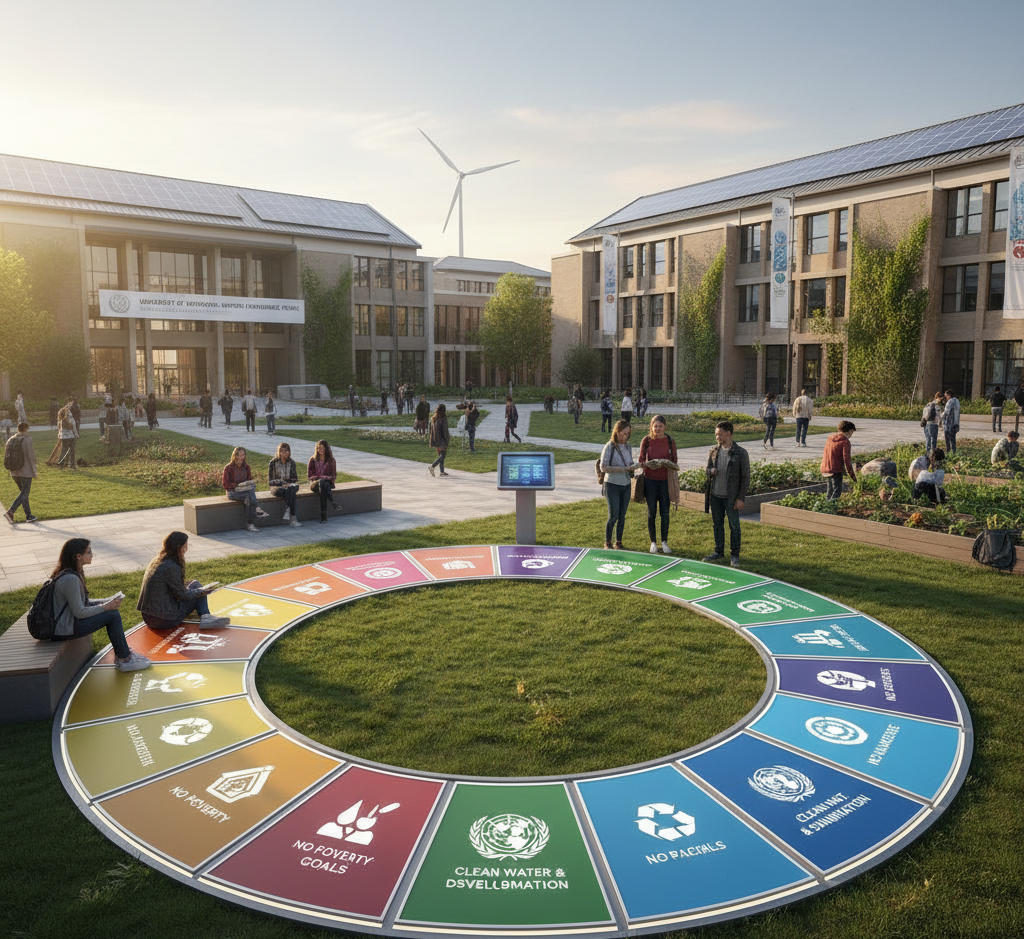Turning UN SDG Goals into Measurable Campus Action Through Green Audits

How Green Audits Help Universities Track and Achieve UN Sustainable Development Goals
- October 10, 2025
- Karthiga S
The UN Sustainable Development Goals (SDGs) provide a global framework for a sustainable, equitable, and resilient future. For educational institutions, these goals are not just aspirational—they are a blueprint for action that shapes campus operations, curriculum, and community engagement.
Yet, many universities struggle to translate SDG ambitions into measurable impact. This is where Green Audits play a pivotal role. By assessing energy, water, waste, and environmental practices on campus, they provide the data, insights, and roadmap needed to turn SDG commitments into tangible outcomes.
From Vision to Measurable Action
Many universities display SDG icons on websites and brochures. But true alignment is proven through action, and measurable action requires evidence-based assessment.
A Green Audit helps campuses:
- Quantify resource use such as energy and water consumption
- Assess waste management practices including recycling and green procurement
- Evaluate infrastructure and operational efficiency across classrooms, labs, and dormitories
These measurable indicators allow institutions to demonstrate real contributions to SDGs like clean water (SDG 6), clean energy (SDG 7), responsible consumption (SDG 12), and climate action (SDG 13).
By moving from intention to evidence, campuses gain credibility, visibility, and a framework for continuous improvement.
How Green Audits Guide SDG Prioritization
Not all SDGs are equally relevant to every institution. While universities may aspire to address multiple goals, resource constraints and campus context make prioritization essential. Green Audits serve as a strategic compass, identifying high-impact areas where efforts will generate measurable results.
Biodiversity & Ecosystem (SDG 15)
Green Audits help assess the ecological footprint of a campus:
- Campus green spaces: Measure the extent of lawns, gardens, and landscaped areas
- Ecological restoration: Identify areas suitable for native flora restoration and pollinator-friendly zones
These insights allow universities to enhance biodiversity, create learning opportunities for students, and contribute meaningfully to SDG 15.
Sustainable Communities (SDG 11)
Universities are microcosms of cities. Green Audits highlight ways to create sustainable, inclusive campus environments:
- Accessibility audits: Review ramps, pathways, restrooms, and classrooms for inclusivity
- Sustainable transport: Track bicycle usage, shuttle services, and electric vehicle charging availability
- Infrastructure efficiency: Assess energy-efficient buildings, optimized lighting, and green roofs
Through these measures, institutions can prioritize initiatives that enhance inclusivity, safety, and environmental performance, while modeling sustainable communities.
Health & Well-being (SDG 3)
A campus is only sustainable if it supports the well-being of its community. Green Audits uncover gaps in:
- Waste management: Evaluate segregation, recycling, and disposal of hazardous materials
- Hygiene infrastructure: Assess drinking water quality, sanitation practices, and restroom facilities
- Wellness initiatives: Review green spaces, recreational areas, and programs promoting physical and mental health
These insights allow universities to improve community well-being, demonstrating measurable contributions to SDG 3.

Measuring, Reporting, and Improving
Green Audits provide baseline data for every SDG-related initiative, forming the foundation for:
- Internal sustainability reporting
- Accreditation readiness and global recognition
- Tracking progress over time for continuous improvement
By transforming ambitions into data-driven insights, Green Audits enable campuses to prioritize investments, track measurable outcomes, and validate their contributions to global goals.
At Aspira Certifications, we help institutions translate SDG commitments into actionable strategies through robust Green Audits. Our approach ensures universities not only track and measure progress but also gain insights that guide impactful, long-term sustainability initiatives.
The Strategic Benefits of SDG Alignment Through Green Audits
- Data-Driven Decisions: Understand what works and where to invest resources for maximum impact
- Credibility and Recognition: Demonstrate measurable outcomes to students, faculty, stakeholders, and accreditation bodies
- Operational Efficiency: Identify opportunities to reduce water, energy, and material consumption
- Community Leadership: Serve as a model for sustainable practices within the region
By linking campus operations directly to SDG targets, Green Audits transform sustainability from abstract vision into measurable action.
Aligning with the UN SDGs is no longer optional—it is central to the future of higher education.
Through Green Audits, universities can:
- Track measurable contributions to SDGs
- Identify high-impact initiatives based on campus-specific insights
- Report progress credibly to stakeholders and global frameworks
At Aspira Certifications, we partner with institutions to make this transformation tangible — guiding them through structured Green Audits, data interpretation, and performance benchmarking aligned with SDG priorities.
Our approach helps campuses not just comply, but lead with purpose, accountability, and measurable progress.
Because when sustainability is measured — it becomes meaningful.
Post Tags :
About Us
We are a team of certified professionals with expertise in green audits and Hygiene Rating Audits, driven by industry standards and sustainability best practices. Our comprehensive inspection services help institutions and businesses improve environmental performance, enhance hygiene compliance, and align with national and global standards.





